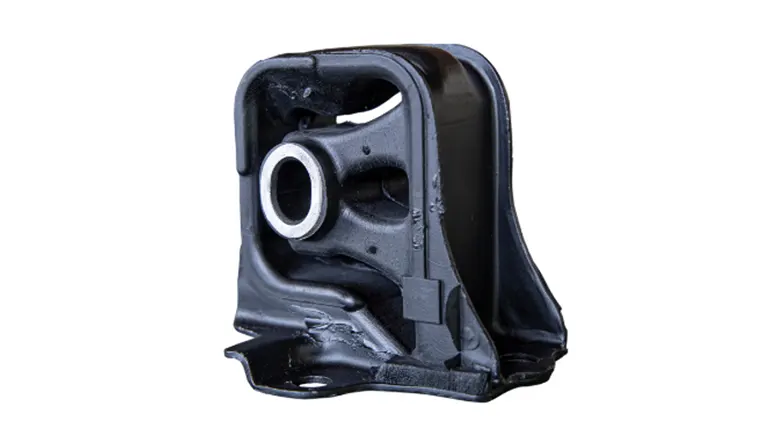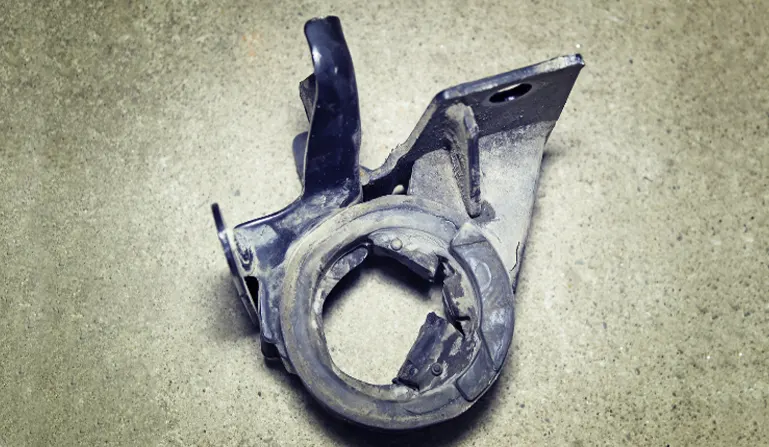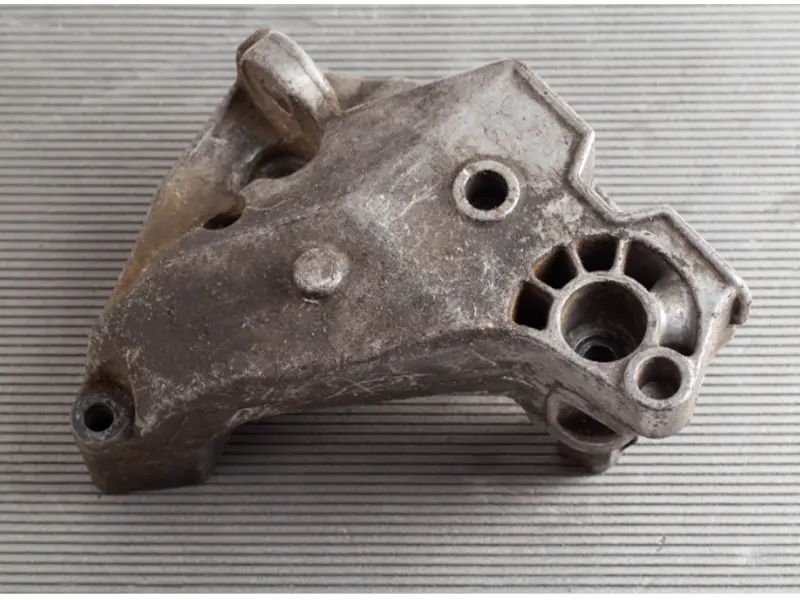An engine mount or motor mount keeps your engine secured in the body of the vehicle. They are located between the engine block and the vehicle frame, or between components such as transmission and suspension parts.
If you a proud owner of a car, you need to know about what is an engine mount, what does it do, the common issues that can arise, and finally, how to take care of your engine mount. So let’s jump into the topic and learn more about the engine mounts in your car as shown in the word cloud.
What is engine mounts?
Engine mounts are crucial components in a vehicle that secure the engine to the chassis, preventing it from moving or vibrating excessively while operating. They are typically made of rubber and metal, with the rubber helping to dampen vibrations and the metal providing structural support.
Engine mounts not only stabilize the engine within the vehicle but also help in reducing the transmission of engine vibrations to the vehicle’s frame, ensuring a smoother and quieter ride.
What does the engine mount do?
The most important tasks of an engine mounts are;
- Secures an engine in its place: As the name defines it, an engine mount holds the engine to the chassis.
- Reduce noise, vibration, and harshness (NVH), and protect other components from damage: As you drive along, there are a lot of activities happening around the engine such as rotations, and vibrations.
When these happen around, the ride would be a dreadful experience. Thanks to engine mounts, NVH is not a problem for the driver or the passengers, because the noise, vibrations, as well as harshness, is dampened by the engine mounts. It also avoids the NVH from being transmitted to the other parts of the car.
This image below shoes how a new rubber engine mount looks like.

What are the different types of engine mounts?
- Rubber motor mounts: This is the most commonly used type of motor mount. It has two metal plates bolted to the engine and the car’s frame.
- Hydraulic motor mounts: Later on, car manufacturers began to manufacture hydro mounts with fluid-filled chambers.
- Hydro mounts have gained popularity over rubber mounts, because the fluid absorbs vibrations from the engine better than rubber mounts. High-performance cars like sports cars use hydraulic mounts. However, they are more expensive than conventional rubber mounts.
- Active engine mounts: This is a further development of the engine mounts. Some active mounts are electrically controlled while the others are vacuum controlled to absorb vibrations at a higher level. The active mounts overcome the limitations of both rubber mounts and hydro mounts.
How many motor mounts are in a car?
Generally, a car has three to four engine mounts. A rear-wheel car has an engine mount on either side of the vehicle. On the other hand, a front-wheel car tends to have three mounts for the engine.
How Long Do Engine Mounts Last?
On average, engine mounts can last anywhere between 50,000 to 100,000 miles or approximately 5 to 10 years. The lifespan of engine mounts varies depending on several factors such as the quality of the mounts, driving style, and the condition of the roads as well as how you would maintain the vehicle.
If you keep the vehicle in good condition and travel smooth surface conditions, the engine mounts will last longer.
Is engine mount a serious problem?
Yes, engine mount issues can be a serious problem due to it’s playing a vital role in stabilizing the engine and reducing vibrations throughout the vehicle.
Engine mounts, while durable, are not immune to issues and can encounter various problems that might impact vehicle performance and driver comfort. Here’s a more detailed exploration of the common issues associated with engine mounts:
- Wear and Tear: Engine mounts are subjected to constant stress and vibration from the engine. Over time, factors like age, mileage, and driving style, especially frequent hard accelerations or driving on rough terrains, can expedite the wear and tear process, diminishing their effectiveness in isolating engine vibrations.
- Cracks and Breakage: The rubber or polyurethane portion of the engine mount, responsible for absorbing vibrations, can develop cracks or even break over time. This is often due to the perpetual stress and heat from the engine, eventually leading to a failure in dampening engine vibrations effectively.
- Looseness: An engine mount can become loose due to deteriorated fastening hardware or misalignment. Loose engine mounts can lead to increased vibrations, jolts during acceleration, and even cause the engine to shift or sag.
- Leakage: Some engine mounts are fluid-filled (hydraulic mounts) to enhance vibration dampening. Over time, these mounts can leak the fluid, significantly reducing their ability to absorb vibrations and leading to a rougher driving experience.
- Misalignment: Engine mounts need to be precisely aligned to effectively balance and support the engine. Misalignment, often due to improper installation or a collision, can result in uneven wear and additional stress on the mounts and related components.
- Corrosion: In some instances, the metallic parts of the engine mounts can corrode, especially in environments with high salinity or excessive moisture. Corrosion can weaken the structural integrity of the mount, leading to premature failure.
- Excessive Heat: Continuous exposure to the high temperatures generated by the engine can cause the rubber or polyurethane part of the mount to harden and become brittle, reducing its ability to absorb vibrations and increasing the likelihood of cracks developing.
- Impact Damage: Engine mounts can also be damaged by impacts, such as driving over a large pothole or a minor collision. Such impacts can cause cracks, misalignment, or even breakage of the engine mounts.
Is it safe to drive with bad engine mounts?
No, it is not safe to drive with bad engine mounts. Damaged or failing engine mounts can lead to excessive engine vibrations and movement, potentially causing further damage and creating an unsafe driving condition.
Do I need to replace all engine mounts at once?
No, you do not necessarily need to replace all engine mounts at once. However, it’s often recommended to inspect all of them if one is failing, as others may also be worn or damaged and could benefit from simultaneous replacement to ensure uniform wear and performance. Always consult with a professional mechanic to determine the best course of action for your specific vehicle.
Below image shows a broken down engine mount that has removed from a engine.

What happens if you don’t change your engine mounts?
Wearing down engine mounts is inevitable over time and usage, and failure to replace them could result in several problems.
If the failed motor mount is not replaced on time, it could lead to a lack of support. There is also a road risk as other vehicle components could break or fly off due to wear.
Secondly, engine misalignment or movement may occur, especially when accelerating or driving at high speeds, causing damage to the engine itself.
Also, the vibration generated from worn engine mounts can affect other vehicle components, such as fan belts or radiator hoses, resulting in stretching or snapping.
Therefore, it’s crucial to have the engine checked and consider replacing worn engine mounts to maintain the overall health of your vehicle.
What to Do When You Identify Problems with Your Engine Mounts?
Recognizing and addressing issues with engine mounts in a timely manner is pivotal to maintaining the optimal performance and safety of your vehicle. Here’s a more detailed guide on what to do when you identify problems with your engine mounts:
- Inspect the mounts: Conduct a visual check to identify any visible signs of wear or damage, such as cracks or breaks in the rubber components of the mounts.
- Listen for unusual noises: Be attentive to any abnormal sounds, like clunking or rattling, which might indicate a problem with the mounts.
- Check for engine misalignment: Observe the engine’s position; if it appears tilted or sagging, it might be due to mount issues.
- Get a professional diagnosis: Ensure to have a professional mechanic assess the condition of the engine mounts to determine the extent of any issues accurately.
- Replace the mounts: If damage is identified, replacement of the mounts is typically necessary. Given the complexity of the task, having a professional mechanic handle the replacement is often recommended.
If the mounts are damaged beyond repair, they will need to be replaced. Replacing the mounts can be a complex and involved process, so it is recommended to have a professional handle the job.
By addressing problems with your engine mounts promptly, you can prevent further damage to your vehicle and ensure safe and reliable operation.
How much do I have to spend to replace the engine mount?
According to Autozone, a rubber mount starts around $10 and depending on the model of the vehicle and the make, it can rise upto $150. On the other hand, a hydraulic motor mount will cost you $50-$200.
How to maintain your engine mount in good condition?
- Check for any leaks: Check the engine mounts to see if there are any oil or coolant leaks.
- Keep your engine clean: Also, clean the engine mount to get rid of any debris, dirt or grime.
- Regular inspections: Get the engine mounts inspected once in a while by a professional mechanic.
- Avoid overloading your vehicle: Do not overload the vehicle so as to prevent the engine mounts from getting damaged.
- Avoid harsh driving conditions: Avoid unnecessary movements in the car such as rapid accelerations and aggressive braking to keep your engine mounts performing smoothly.
Top Engine Mounts Manufacturers
Summary
On a final note, checking your engine mounts regularly and maintaining them in a good condition can increase the life span of the engine mount, avoiding unexpected costly repairs or replacements.

John Smith, a Los Angeles-based car specialist and automotive writer, boasts over 20 years in the industry. With a background as a master technician and a decade-long writing stint at notable automotive publications, John now shares his expansive knowledge on CarFinite, simplifying car maintenance for readers.

